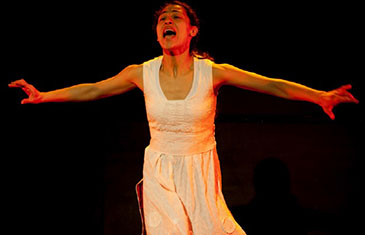The Potential of Collaboration between the Arts and Research

Written by Cathy McIlwaine, Professor of Geography at the School of Geography
‘Juana in a Million: Making Latin Americans Visible in London’ was a symposium at Southwark Playhouse that integrated performance with social science research. It featured a performance of
, a one-woman performance exploring true stories of Latin American migrants to the UK, and an accompanying workshop of actors/performers, community activists and researchers.
Juana in a Million was written by Mexican author-performer Vicky Araico Casas, who was inspired by real life experiences captured through my research report No Longer Invisible on the situation of the Latin American community in London.
Because Vicky had used my research to write the play, we wanted to bring together others who worked on issues relating to Latin American migration in the UK to address the lessons learnt and the ways in which the arts and performance intersect with academic social science research. We also wanted to explore how to facilitate a larger and more diverse audience for the play far beyond the Latin American community itself. Ultimately, this was part of the shared aim of both areas of work which is to raise the profile and reduce the invisibility of the Latin American community in London and the UK more widely.
The symposium took place during Juana in a Million's 25 day run in Southwark and we shaped it to link directly with the performance. We found that linking workshops with performance really brought core issues to the fore in a very real way and enhanced participation as everyone was affected by the play and able to discuss it in a more engaged manner.
The performing arts have increasingly been recognised as an important medium through which the powerless can express their experiences, hopes and fears. Theatre in particular is important in representing these experiences and assisting in the creation of new identities as well as in providing a channel through which to challenge resistance to injustice. Indeed, theatre practice can express and also potentially transform existing social contexts.
From an academic research perspective, there is a long history of the need for participatory methodological approaches to examine and understand the lives of those who are disenfranchised in some way and have no voice, dating back to the work of Paulo Freire in the favelas of Brazil.

Academics within the social sciences and educational research in particular have increasingly used participatory theatre, video and drama when working with excluded groups in an effort to build social relations, heal the scars of conflict and to bring about positive social change.
In the world of drama, an Applied Theatre (AT) approach has been influential in working with discriminated and excluded groups with the aim of addressing existing power relations, raising issues that are often left unspoken and bringing about longer term transformation. Theatre and performance can therefore be used as powerful tools to enable people to express their reality in ways that communicates to others.
Increasingly the worlds of social science research and the arts are coming together in fruitful and mutually constitutive ways that feed into one another. The academic research informs the theatre and performing arts can draw on the academic research. In turn, the research itself is transformed as it can communicate more effectively with a range of different audiences in ways that the written word cannot. Partly because of the potential to uncover the experiences of the excluded and powerless in ways that can be socially transformative, the performing arts have increasingly worked with refugees and migrant groups.
An interesting example of this is the work by Alison Blunt and her colleagues, also at Queen Mary, who explored the meanings of home among Polish, Kurdish, Somali and Vietnamese migrants to London through London Bubble’s (a theatre company) performances of ‘My Home’. The aim of these performances was to make the experiences of these groups more accessible for the creators and audience alike. As Blunt et al. (2007, p.310) note: ‘The theatre company’s concept of a ‘bubble’ is played out dually: they aim to examine the everyday issues that arise within the ephemeral, ever-changing ‘bubble-like’ spaces within which London’s various communities intersect; and to do so through a ‘bubble’ of ideas and energy wherever they perform’.
As well as awareness-raising and sharing ideas and practice, the importance of these types of initiatives is also to allow communities themselves to assert themselves and improve their lives. Indeed, the work of the People's Palace Projects and Paul Heritage at Queen Mary has highlighted the importance of practice-based arts research in Brazil in raising awareness of marginalisation and violence and how cultural interventions can empower communities through organisations such as AfroReggae and Crescer e Vivir.

Photo by Pablo Allison
Many dimensions of these debates emerge in Vicky Araico Casas’s Juana in a Million. Not only does it showcase the life of one particular Latin American migrant in London based on the No Longer Invisible research, but it powerfully highlights the experience of Juana’s marginalisation and exclusion to an audience that might not necessarily be aware that Latin Americans are one of the fastest growing yet most discriminated against groups in London.
The performances at the Southwark Playhouse together with various associated activities with Queen Mary and the Latin American Women’s Rights Service also aimed to continue to strive to bring about positive social change for this particular community who have contributed so much to the city. By using theatre to communicate the challenges of being a Latin American migrant in London we’ve found that the findings from the research project were communicated via the play in ways that the written word is not able to.
The funding from the Centre for Public Engagement was crucial in making the symposium around Juana in a Million happen. This is hopefully the beginning of future collaborations with theatre organisations such as CASA which first funded Juana in a Million and with whom I’m currently developing new initiatives.
For a preview of the Juana in a Million performance, you can watch their Youtube video here.
By Cathy McIlwaine
Professor of Geography
School of Geography